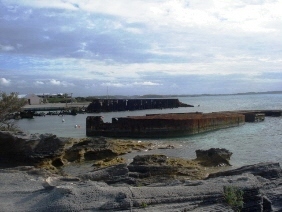When you first explore Spanish Point you may be forgiven for wanting to go home and contact Greenpeace about dumping at sea. For, sitting in the mouth of Stoves Bay is a rusty hulk, which, if not quite of Brobdingnagian proportions, dominates the view across to Dockyard. If it wasn’t there you could see past Long Point to Cobblers Island, Lapstone, Nets Rock and beyond Hogfish Beacon across the Great Sound Ledge to Pepperpot Beacon and Cockburn’s Cut. It is from across the water that this sad skeletal shell originated. Once, tidily tucked behind the safety of the South Breakwater, it was HMS Bermuda Floating Dock.
If you think of Bermuda as a giant fish-hook then Ireland island is the tip of the hook, the far end of Middle Road, the last of the rocky outcrops connected by short bridges, reaching out into the deeper waters of the oddly named Grassy Bay. Ferry across the Great Sound is the quickest route.
A patient explanation from my husband told me that while small boats can be careened (nautical jargon for tilted) to one side for repairs and cleaning, larger ships require some form of dry-docking. Bermuda limestone is too soft and porous for a water-tight dry dock construction (which is also the explanation of occasional wet walls indoors in old Bermuda homes) so an alternative solution was necessary.
The floating dock was proposed by Lord Clarence Paget in 1866:
The only further work connected with this Vote relates to the proposed dock at Bermuda, We propose to construct a great iron floating dock, and there have been various plans before us for the execution of this work. One of these is quite of a novel and ingenious character. I do not venture to describe it, but I intend to lay a model of it in the Library, that hon. Members may see it for themselves. The plan, although it is one of a hydraulic first-class dock, dispenses almost altogether with any steam machinery; and, what is still more remarkable, the inventor proposes to build it here and to go out in it. (from Hansard, Commons Sittings)
The model mentioned in the above paragraph is kept at the Science Museum, London. The design was patented by James Campbell and construction began at Woolwich in 1866.
The dock was 381 feet long by 123 feet wide and 74 feet deep. This was big enough to take ships of the Bellerophon class.
The building was completed by 1868. It cost £247,589 5s. 7d. to build. (Hansard)
Two steam-sail ironclads, HMS Agincourt and HMS Northumberland towed the dock as far as Madeira, then HMS Warrior and HMS Black Prince, the most powerful ironclads of the fleet, took it across the Atlantic. A sail was placed inside the U-shaped dock to make use of following winds and HMS Terrible guided the stern for the whole journey.
July 4th 1869 as they left Ponto Santo
(National Maritime Museum)
There is a picture of HMS Warrior resting inside the floating dock with the dock in an elevated position – this is taken from an engraving by Thomas Dutton, but is historically inaccurate – it never happened – more a product of his imagination.
The dock was used through until 1906; more than 78 lifts are documented in the Dockyard records.
But after 40 years service she was no longer big enough to manage the Royal Navy Dreadnought class of the early 1900s. (Confusingly the navy re-use ship names so the famous Flagship HMS Dreadnought of 1906 was actually the sixth ship of that name)
The next part of the story, how the dock ended up ay Spanish Point, has two versions and I have not been able to unravel the truth. Two Bermudian experts, Edward Harris and Richard Gould, have tried before me. The former describes the arrival of the floating dock at
http://www.bermudarentals.com/wp-content/uploads/HMAFDBda.pdf
But it is Richard Gould who provides detail of the dismantling process and proposes a story to explain how it becomes abandoned. In 1996 Gould and Souza published results of an archeological exploration of the wreck – History and Archaeology of HM Floating Dock Bermuda, International Journal of Nautical Archaeology 1996 25,1:4 20. They quote from an unpublished diary of a dock worker at the time, D Barrit, who described the arrival of German ship-breakers in January 1907. It took over a year to remove the copper, bronze and brass which was done in-situ at the dockyard, then in March 1908 tugs hauled the remains to the opposite shore and secured it with anchors and hawsers. Subsequently it seems the hulk broke free of the restraints during storms and drifted to block the mouth of the bay.
In April 1908 a Certificate of Abandonment was issued.
In the mid twentieth century attempts were made to reduce the wreckage with dynamite. It was partially successful and opened up a channel through for small boats, but the remains are still clearly visible. When we were there this weekend a heron was using the elevation to find its lunch, but I wasn’t quick enough with the camera.
Does it fall under UNESCO’s underwater heritage protection rules?
Is it heritage or an eyesore?







